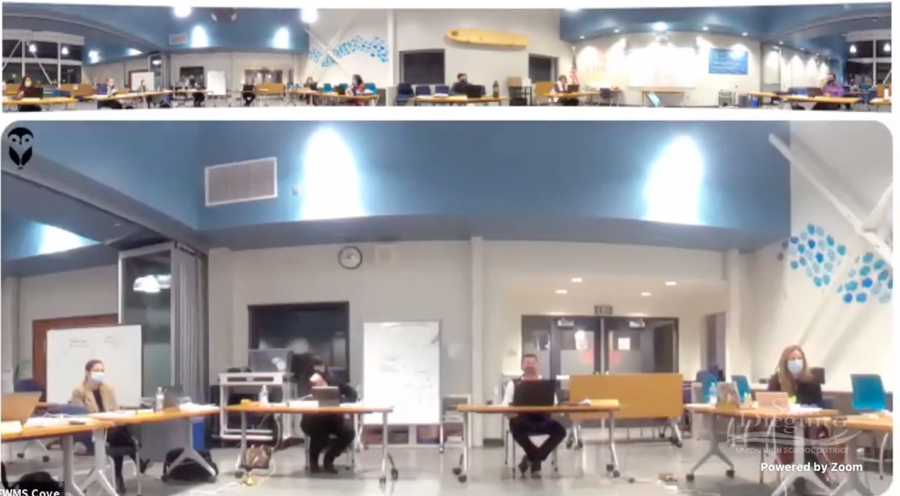Screenshot of SDUHSD Board Meeting
Board members discuss the following at Earl Warren Middle School on Dec. 15 and Dec. 17
San Dieguito board members discuss fully reopening schools and more
Everything you need to know about the proposed time change for school board meetings, legal council, and the reopening of schools
December 17, 2020
DECEMBER 15– The San Dieguito Union High School District board members, student representatives, and a board of medical professionals met in a physical/virtual hybrid environment for their final board meeting of the year. The meeting’s events included officially inaugurating two new board members– Katrina Young and Micheal Allman– and touching upon several agenda items.
Before introducing the first agenda item, the board members opened the floor for public comment, many of which centered around anger towards the school board’s physical location for a meeting and their proposal to move their meeting time from 5 pm to 9 am.
Many commenters argued that this change would particularly impact the student board members, for they “may have particularly challenging conflicts with morning as it requires them to miss a class or miss the meetings,” commented Adam Fischer. “Therefore, please keep all meetings in the afternoons or evenings, so as not to exclude these important voices in the community.”
Teachers and parents of the district also dissented, arguing this time change will harm student and teacher involvement on the school board and “would be counterproductive to transparency and accessibility,” said commenter Julie Bronstein.
“Democracy cannot stand without the people in it.,” commented Justin Davis, a junior at Canyon Crest Academy, against the board’s proposal to change their meeting time. He stated that this change is “an attempt to suppress our voices.”
A few voices also brought forth the notion that these school board meetings should be held completely virtually because school board members are not considered essential workers and that in-person meetings violate the Stay-at-Home order currently in place in our county.
In response to these comments, board Trustee Melisse Mossy said this meeting time would actually lead to more inclusion because the meetings at the current start time of 5 pm run until 11:00 pm, preventing many individuals from attending the entire meeting. “If 9 o’clock doesn’t work, I am completely open to any other suggestions,” said Mossy. “This is certainly not any means to exclude anyone.” She says she consulted school staff and was told that meeting at this time would not be an issue.
In response, Mossy moved to amend the suggestion to instead change the meeting time to 3 pm instead of 5 pm, and the motion passed, changing the official start time of the school board meetings to 3 pm.
After a brief closed session, the board reconvened and opened the floor for public comments on non-agenda items. Individuals submitted over 50 comments, topics ranging from continued disapproval towards the board meetings being held in person and the SDUHSD Superintendent Robert Haley specifically.
Additionally, a CCA student-parent implored the board to allow teachers to continue to teach virtually once on-campus education resumes if they would otherwise be compromising their health by teaching in-person.
However, some individuals utilized their two minutes of speaking time to commend the school district for its handling of education during the coronavirus, which one math teacher in the district said is “working for many, many students,” and that “the site administration is doing their absolute best to support every student and every teacher.” A San Dieguito Academy freshman and sophomore student’s parent commended SDA’s handling of distance learning specifically.
The next item on the agenda concerned a law firm which new board Trustee Allman proposed the school board hires to sit-in on all school board meetings and provide legal counsel. Before deliberation on the issue could commence, the board opened the floor for public comments on the matter.
A teacher and parent in the district expressed her apprehension towards the proposition, stating that “Mr. Allman has not earned the trust of many in our community and the optics of him proposing a particular law firm… upon his first board meeting without any context to our district’s legal needs,… is suspect.”
Another parent also stated that introducing a legal council in the first place was “not a transparent process,” and others raised concern over the particular law firm Allman selected, which has significant experience with charter and private schools. “Why wouldn’t a public school board seek bids for legal services from neutral firms, not firms which seek to funnel money away from the public school system?” questioned a commenter.
However, another speaker disagreed with this, arguing that the charter school alliance with this law firm is not pertinent information, and all that is necessary to know is their experience.
Once board deliberation began, Allman defended his position, adamant that the school board requires legal counsel during its meetings. “We need a lawyer in this room,” said Allman, who defends his choice of lawyer, stating that “he was recommended by several of our constituents in our district.” Additionally, it was revealed that Allman had met this lawyer in early-mid November before he was elected to office.
Board member Young argues that speaking of this addition of legal counsel “puts us in legal peril,” since Allman was merely a Trustee-elect and not yet certified to the office at the date of engagement with this lawyer. “For us to engage in legal council before we have an authorized agent represent the board, I do not know the legal stance of that,” said Young. Additionally, she argues that since Allman and this lawyer have met previously, outside of a professional political setting, that the lawyer is already beholden to him.
However, Haley says this proposal “is not in violation of our bylaws or the Brown Act.”
“I think we need an attorney in this room,” stated Allman in response. “Because I have no idea if what you said was appropriate, legally. I need to be able to look at an attorney and ask them legal questions and get advice… I think if we have someone who hasn’t been involved [in district staff], I think we can get a fresh perspective.”
However, Young also expressed apprehension towards hiring this law firm because she feels that to pay someone else to determine how they run their meetings when “that’s our job, I think, is a reckless way to spend taxpayer money,” said Young.
To this, however, Allman argued that “if it costs us a thousand dollars a meeting, it costs us a thousand dollars a meeting.”
The board generally appeared to agree that having a legal counsel present at every school board meeting would be unnecessary. The hourly cost of a lawyer during these meetings may be too large to justify. Additionally, several argued that they know of a few other boards which adopt this practice that Allman proposes.
In response to this, Allman proposed to advise his proposition and create a sub-committee to come up with new names for the legal council, concluding that item on the agenda.
The next topic of discussion concerned the reopening of schools. There were 145 public comments in total.
Aakash Mishra, a senior at CCA, expressed anger towards Allman’s email to a teacher in the district, where Allman stated, “you [the teacher to which the email was addressed] should not be teaching our kids.” “What use is a democratic council if it does not act on the needs of its constituents?” asked Mishra.
Another student expressed their opinion that reopening will not improve students’ mental health, and “the last thing we as students want is to put our teachers in danger” by returning to in-person education and potentially spreading the virus. “This hybrid model helps no one and hurts all,” said the student. “We ask the board to empathize with our teachers.”
Inversely, some students expressed their excitement to return to in-person education. “I am ready to go to in-person school, five days a week, now… Please open my school,” said a freshman at La Costa Canyon.
Some parents shared this opinion.” I feel strongly… that learning is most effective when in-person,” states a district parent, also citing her confusion about the discrepancies between schools, where varying policies have allowed some schools to have clubs on campus while others do not.
This item on the agenda introduced the virtually present medical board, composed of Doctors Shakha Gillin, Peter Zage, Keri Carstairs, Paul Grossfeld.
The school board asked these doctors what they would say to those worried about the school reopening. “[The plan] is very consistent with what we see that is safe in our community,” said North County Pediatrician Dr. Shakha Gillin. “This is very much standard of what we are doing in our offices in the hospital… and is showing low, low rates of transmission.”
The same doctor supports the controversial “as practicable” statement concerning social distancing made prominent in the school’s reopening plan. “There are absolutely given times where people are closer than six feet and not transmitting,” said Gillin.
Regarding some fears of the public, Allman directed the following question to the medical board: “it appears that kids don’t get sick in school– they get sick elsewhere,” stated Allman. “if we had a policy of kids in school versus kids in school, under which of those two [policies], based on the evidence do we know today, kids would get coronavirus more often?” he asked. “Would you go as far as to say that… if [students] were in school, they would have fewer coronavirus [cases] than if they weren’t in school?”
To this, Carstairs responded that “I don’t think anybody could say that.” When asked if there has been any transmission of the virus in schools in San Diego County, Gillian responded that “we are not privy to all of that information.” However, she states that the number of transmissions within school boundaries is very low.
Some of the doctors on the panel sympathized with individuals’ concern with returning to in-person education. When asked if he would send his kids back to school, Dr. Peter Zage said that his child is “quite happy to stay at home and continue distance learning… I think… he would be scared for himself and the teachers and the other students by going back.”
To this, Allman stated that “he wouldn’t be scared for himself… why would a teenager be scared of catching coronavirus?… Teenagers, I’m talking about.”
This statement was met unfavorably by the student representatives from the various high schools in the district, one dissenter being Carrie Su, the CCA representative. “As teenagers… we have a complete right to be scared about returning to school,” said Su, who also argued to bring clubs back to school, not the entire student body. Representative Cassie Miller from SDA also shared her concerns about returning to school.
In response, Allman questioned the worth of having student representatives at school board meetings. “I would propose that we have a discussion right now about the value of the ASB students [on the board],” said Allman. “I think the value that they provided, in what we have to decide is very near zero.”
He argued that these student representatives’ viewpoint, which Allman referred to as “young kids,” should not be highly considered. “This is a serious topic,” said Allman, “but to think that this board should place very much weight at all on what a couple of individual high schoolers think is a dereliction.”
Student representatives have only a symbolic vote, and their main duty during school board meetings is to voice their respective schools’ opinions.
A significant portion of the discussion on this item referred back to the reopening plan, and many of the subjects touched upon in the return-to-school proposal during the last school board meeting.
In closure, the board assures that it is still prepared to have all students return to in-person schooling on January 4th, according to the guidelines lined out in the reopening plan.
The final topic concerned the adoption of a resolution regarding the expanded school opening. Allman was the sole author of this resolution, an action found odd by the other, more experienced board members.
The resolution stated very broadly that all students across all SDUHSD schools would be given a choice to return to campus five days a week. However, as the board introduced this discussion topic near 11 pm– when the meeting ended– the nuances of this resolution were left open-ended and ill-defined.
Board member Mossy then edited the resolution proposed by Allman, and this altered proposal passed with a 3/2 vote with Trustees Allman, Mossy, and Mo voting in favor. All student representatives voted against the measure.
The passage of this resolution was met with criticism, for the board did not open the floor for public comment on the revised proposal, and they did not share the content of the revised proposal with the public before voting.
As not yet half of the agenda items were touched upon during this board meeting, the board will reconvene tonight, December 17, at 5:00 pm to continue the discussion.
Go to the SDUHSD website to watch the live stream of the second installment of the board meeting; the link will be live at 5:00 pm.


